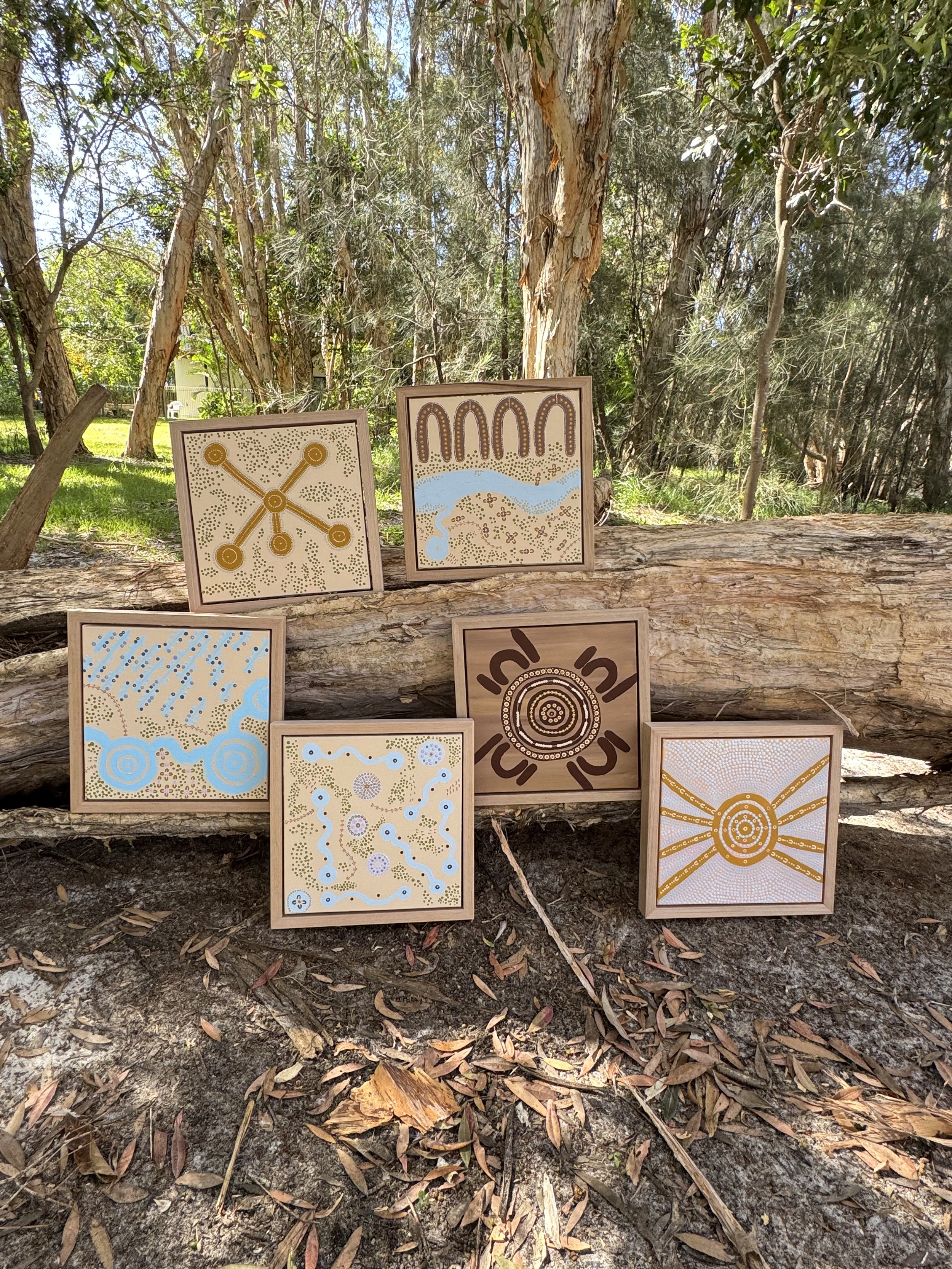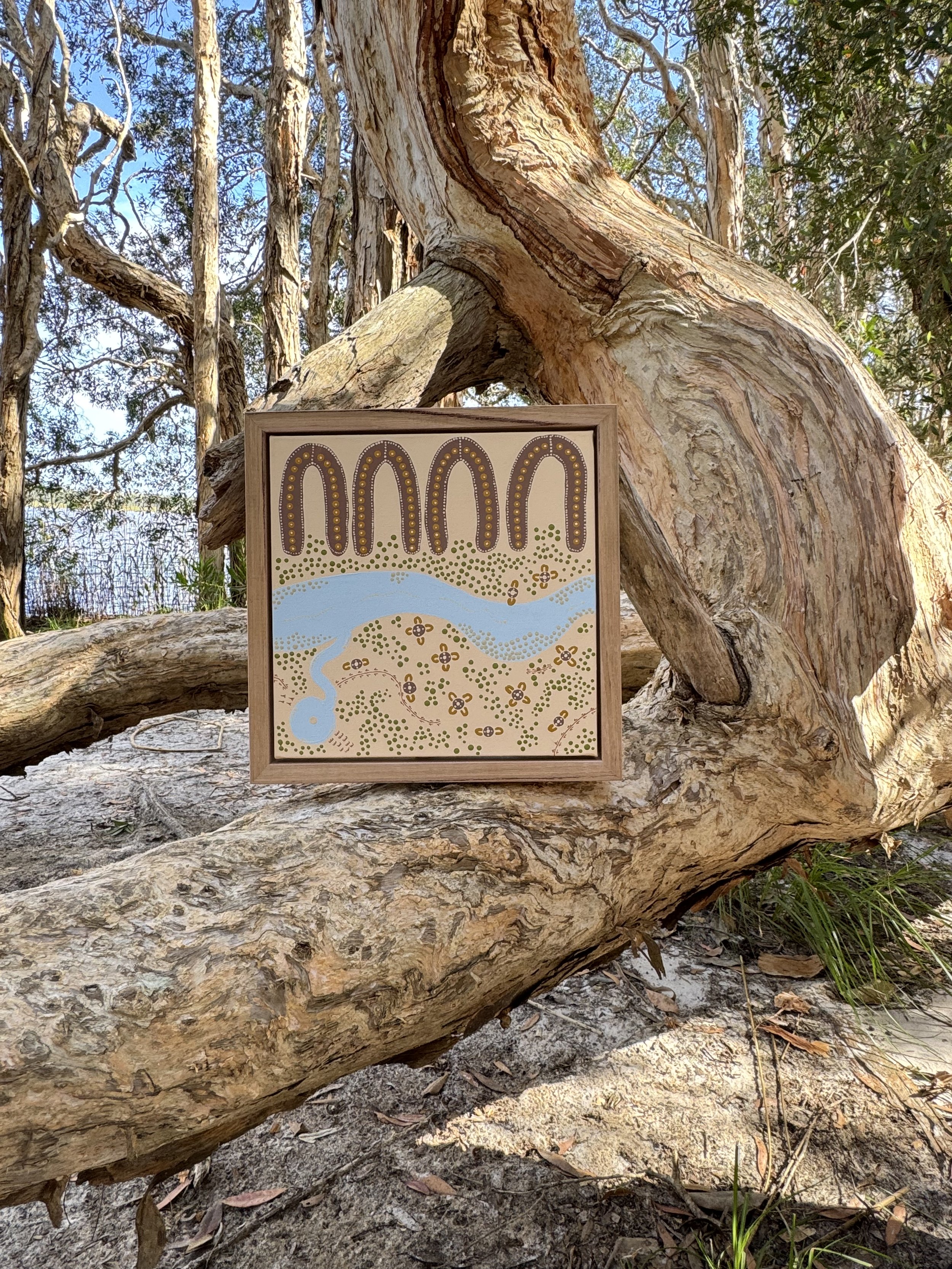 Image 1 of 3
Image 1 of 3

 Image 2 of 3
Image 2 of 3

 Image 3 of 3
Image 3 of 3




Hunt and Gather
Hunt and gather - to live off our land sustainably. To honour our men’s business and our women’s business. This piece is about our tribe working together in abundance, sharing our teachings and honouring our cultural practices.
The arches represent the mountain range and the green dots are the foliage and dense bushland. In this piece, there are animal tracks of kangaroos, possums and emu. The blue freshwater creek flows through the centre of the canvas intentionally, as the freshwater is the main focus for survival and abundant animals. The sand-coloured dots in the creek represent the shallow stone banks. The tribe gathers around their abundant lands going about their allocated business.
Hunt and Gather encapsulate the essence of living in harmony with the land, honouring the balance of men’s business and women’s business, and celebrating the sustainable practices that have been passed down through generations. This piece reflects the interdependent relationship between the tribe and the land, where everyone plays a vital role in the circle of life, ensuring the survival and prosperity of their community. It speaks to the collective effort, the sharing of knowledge, and the honouring of cultural practices that allow the tribe to live off the land while maintaining respect for the environment.
The arches in the piece represent the mountain range, standing as silent guardians of the land. The mountains are symbolic of both the physical and spiritual boundaries that define the territory of the tribe. These arches signify the strength, stability, and eternal presence of the land, a reminder that the tribe is deeply rooted in the traditions and teachings that come from this sacred space. The mountains also serve as landmarks—natural markers that guide the tribe and offer protection, serving as a foundation for all activities that take place within the landscape.
The green dots scattered throughout the canvas represent the foliage and dense bushland that surround and nourish the tribe. These dots evoke the rich natural environment that sustains the people, with the green symbolising life, growth, and vitality. The bushland is not just a source of sustenance but also a space for learning, reflection, and honouring the teachings of the elders. It represents abundance—the wild and untamed beauty of nature that is essential to the tribe's way of life.
Within the bushland, there are the animal tracks of kangaroos, possums, and emus—creatures that the tribe depends upon for sustenance, but also for their spiritual and cultural significance. The tracks are more than just physical marks left on the earth; they are symbols of the life cycle, of the relationships between the people and the animals, and of the hunting and gathering practices that allow the tribe to live in balance with nature. These tracks serve as a visual narrative, showing the ongoing movement and life of the animals and the ways in which they are intertwined with the tribe’s own journey.
The blue freshwater creek flowing through the centre of the canvas is the main focus of survival—a vital source of life and abundance. Freshwater is the lifeblood of the land, and its flow is depicted as intentionally central to the piece, representing its role in sustaining both the people and the animals. The creek is a source of nourishment, a place of gathering, and an essential element that ties the land and the people together. Its path is fluid, symbolizing both the movement of water and the ongoing cycle of life. The blue represents both calmness and clarity—factors essential to the tribe's survival, and a reminder of the clarity and peace that come from respecting the water and the land.
The sand-coloured dots in the creek symbolize the shallow stone banks of the waterway. These dots evoke the presence of stones and sediment, the quiet, grounding elements that form the foundation of the creek bed. The stones speak to the stability and permanence of the land, as well as the timeless nature of the relationship between the water and the earth. Together with the flowing water, they represent the cyclical balance that sustains the ecosystem.
The tribe itself is depicted as gathering around their abundant lands; each person engaged in their allocated business. This symbolises the division of labour and the respect for both men’s business and women’s business—roles that have been passed down and are vital for the functioning of the community. The men may be engaged in hunting and gathering, while the women manage the land, food preparation, and the nurturing of the community. Both are equally important in maintaining balance and abundance. The cooperative nature of the tribe is emphasised—each member plays a specific, but equally vital, role in sustaining the harmony of the land.
At its core, Hunt and Gather speaks to the interdependence of life, the respect for the environment, and the celebration of cultural practices. It is about honouring the ancient wisdom passed down through generations, working together as a tribe, and living in balance with the land, ensuring its abundance for future generations. The piece captures the deep connection between the tribe and the land, highlighting the spiritual and practical aspects of living sustainably while maintaining respect for the resources and relationships that sustain life.
Size: 350mm x 350 mm including frame
Frame: Tasmanian Oak 19mm thick, 40 mm deep
Hunt and gather - to live off our land sustainably. To honour our men’s business and our women’s business. This piece is about our tribe working together in abundance, sharing our teachings and honouring our cultural practices.
The arches represent the mountain range and the green dots are the foliage and dense bushland. In this piece, there are animal tracks of kangaroos, possums and emu. The blue freshwater creek flows through the centre of the canvas intentionally, as the freshwater is the main focus for survival and abundant animals. The sand-coloured dots in the creek represent the shallow stone banks. The tribe gathers around their abundant lands going about their allocated business.
Hunt and Gather encapsulate the essence of living in harmony with the land, honouring the balance of men’s business and women’s business, and celebrating the sustainable practices that have been passed down through generations. This piece reflects the interdependent relationship between the tribe and the land, where everyone plays a vital role in the circle of life, ensuring the survival and prosperity of their community. It speaks to the collective effort, the sharing of knowledge, and the honouring of cultural practices that allow the tribe to live off the land while maintaining respect for the environment.
The arches in the piece represent the mountain range, standing as silent guardians of the land. The mountains are symbolic of both the physical and spiritual boundaries that define the territory of the tribe. These arches signify the strength, stability, and eternal presence of the land, a reminder that the tribe is deeply rooted in the traditions and teachings that come from this sacred space. The mountains also serve as landmarks—natural markers that guide the tribe and offer protection, serving as a foundation for all activities that take place within the landscape.
The green dots scattered throughout the canvas represent the foliage and dense bushland that surround and nourish the tribe. These dots evoke the rich natural environment that sustains the people, with the green symbolising life, growth, and vitality. The bushland is not just a source of sustenance but also a space for learning, reflection, and honouring the teachings of the elders. It represents abundance—the wild and untamed beauty of nature that is essential to the tribe's way of life.
Within the bushland, there are the animal tracks of kangaroos, possums, and emus—creatures that the tribe depends upon for sustenance, but also for their spiritual and cultural significance. The tracks are more than just physical marks left on the earth; they are symbols of the life cycle, of the relationships between the people and the animals, and of the hunting and gathering practices that allow the tribe to live in balance with nature. These tracks serve as a visual narrative, showing the ongoing movement and life of the animals and the ways in which they are intertwined with the tribe’s own journey.
The blue freshwater creek flowing through the centre of the canvas is the main focus of survival—a vital source of life and abundance. Freshwater is the lifeblood of the land, and its flow is depicted as intentionally central to the piece, representing its role in sustaining both the people and the animals. The creek is a source of nourishment, a place of gathering, and an essential element that ties the land and the people together. Its path is fluid, symbolizing both the movement of water and the ongoing cycle of life. The blue represents both calmness and clarity—factors essential to the tribe's survival, and a reminder of the clarity and peace that come from respecting the water and the land.
The sand-coloured dots in the creek symbolize the shallow stone banks of the waterway. These dots evoke the presence of stones and sediment, the quiet, grounding elements that form the foundation of the creek bed. The stones speak to the stability and permanence of the land, as well as the timeless nature of the relationship between the water and the earth. Together with the flowing water, they represent the cyclical balance that sustains the ecosystem.
The tribe itself is depicted as gathering around their abundant lands; each person engaged in their allocated business. This symbolises the division of labour and the respect for both men’s business and women’s business—roles that have been passed down and are vital for the functioning of the community. The men may be engaged in hunting and gathering, while the women manage the land, food preparation, and the nurturing of the community. Both are equally important in maintaining balance and abundance. The cooperative nature of the tribe is emphasised—each member plays a specific, but equally vital, role in sustaining the harmony of the land.
At its core, Hunt and Gather speaks to the interdependence of life, the respect for the environment, and the celebration of cultural practices. It is about honouring the ancient wisdom passed down through generations, working together as a tribe, and living in balance with the land, ensuring its abundance for future generations. The piece captures the deep connection between the tribe and the land, highlighting the spiritual and practical aspects of living sustainably while maintaining respect for the resources and relationships that sustain life.
Size: 350mm x 350 mm including frame
Frame: Tasmanian Oak 19mm thick, 40 mm deep